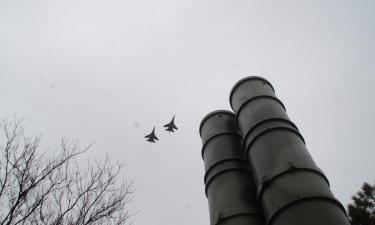Another mystery of Chelyabinsk meteorite unveiled
Many witnesses of the meteorite explosion over Chelyabinsk in February of this year said that they were able to see most interesting things. However, they are mistaken, because there are many things they could not see from the Earth surface. Thankfully, weather satellite Suomi was able to take pictures of all the interesting events that followed immediately after the explosion and provide pictures to scientists.
A renowned expert on small bodies of the Solar System Professor Valentina Prokofieva-Michailovskaya presented at the Crimean Astrophysical Observatory under the framework of COSPAR program the work of her former student, now a doctor of physical and mathematical sciences, the leading data analyst for "Suomi " meteorological satellite Nicholai Gor'kavyi "Small asteroid caused a huge dust ring around the Earth." The interesting satellite observations related to the results of the cosmic collision complete the knowledge of the developments in the Earth's atmosphere after the explosion of the meteorite on February 15, 2013.
A joint project of NASA and NOAA, weather satellite Suomi, was launched on October 28th, 2011. This man-made Earth satellite named after an American meteorologist Verner Suomi is the newest laboratory for the study of terrestrial and aquatic spaces, the atmosphere and clouds, snow and ice of the planet and its vegetation. Telescopes, video and photo cameras, and a variety of sensors are the eyes of the equipment looking down to the Earth. One of the sensors is a limb sensor that looks at the horizon with a thin blue strip of air over it.
During an orbital flight from the South Pole to the north, the limb sensor will measure the atmospheric glow 180 times a day. Three slots aimed at different parts of the horizon will obtain and record the spectra of about 500 atmospheric profiles.
Suomi orbits the Earth 14 times in 24 hours, providing 7,000 atmospheric profiles that can help build a three-dimensional picture of the dust level in the atmosphere. This unusual and unscheduled work had to be conducted later based on the data obtained by Suomi when the exploding fireball brighter than the sun illuminated the end of its trajectory over Chelyabinsk, giving a challenging task to the unsuspecting meteorologists.
The brightest flash of the explosion was followed by a "rain" of rocks, a large meteorite fragments, and dust. Fine dust stayed in the air and spread with the wind. Watching this from the ground proved difficult, as the hot air blast has rapidly gone up in a convective cloud, its velocity was 130 m / s, and some of the dust has been thrown to a height of 10 km.
As mentioned earlier, the numerous and complex equipment of "Suomi" captures various parameters. The data is processed by experts from different companies. The limb sensor under contract with NASA is led by SSAI. Experts process the data, and the processing is very difficult because of the need for a precise calibration of the devices, digitizing of the data and then building a model of the spatial features in the observations.
The first attempt to catch the event was made on February 18th, but was unsuccessful. Three sets of orbital data over Chelyabinsk on February 14, 15 and 16 of 2013 were studied, but the aerosol profiles were indistinguishable from one another, and a signal of "dust" from the meteor was not detected. It is well known that such dust stays in the air for a long time, so the assumption about the weakness of the dust cloud was rejected, and the scientists continued to search for its traces.
On February 19 the second attempt was made with a different approach, and it was clearly effective. All orbits for February 15-18 were taken from "Suomi". A bright aerosol spot with a maximum density at altitudes of 35 km was discovered at the latitude of Chelyabinsk. The main contribution was from the orbit on February 16. The aerosol was recorded over Siberia, many miles east of the explosion.
Data search on February 15 aimed at assessing the side slits of the limb sensor, and was successful. It turned out that the left slot of the sensor caught a dust cloud at an altitude of 30 km above Chelyabinsk five hours after the fall of the meteorite. The right slot on the previous orbit just in 3.5 hours 1,000 km east of Chelyabinsk found a dust cloud. But this signal was weaker, and indicated the altitude of about 40 km. That prompted a hypothesis about the east movement of the cloud over Siberia by strong winds.
Scientists Paul Newman and Arlindo da Silva, experts in atmospheric dynamics, built a computer model taking into account the movement of the wind in the stratosphere over Chelyabinsk. West wind at altitudes of 20 to 50 km was dominant, reaching 85 m / s. The highest part of the convective dust cloud swiftly moved to the east and reached Novosibirsk 3.5 hours later. The lower layers were moving slowly. In the model calculations on February 16 the dust stretched over Siberia, which was consistent with Suomi data. On February 18 the dust has reached North America and appeared in the skies over the Atlantic.
Four days later the dust was seen over Europe and gradually reached Chelyabinsk. For the next three months the dust ring stayed around the Earth at the altitude of 30-40 км. The article in Geophysical Research Letters on June 26 2013 for the first time presented the obtained data. A co-author of the work was A. Dadurov, a professor at Chelyabinsk University who first collected the meteorite dust on the snow around Chelyabinsk and who continued studying the dust component.
Later, on August 14, 2013 NASA published a press release with the study results.
The results obtained by Suomi are interesting because the fall of such a relatively small asteroid has produced large-scale consequences. The discovered dust plume served as a convincing evidence of the effect of small space bodies on the Earth. The reality of the asteroid danger was confirmed by the incident with Chelyabinsk meteorite that was heavily studied by scientists.
Tatyana Valchuk
Pravda.Ru
Subscribe to Pravda.Ru Telegram channel, Facebook, RSS!





